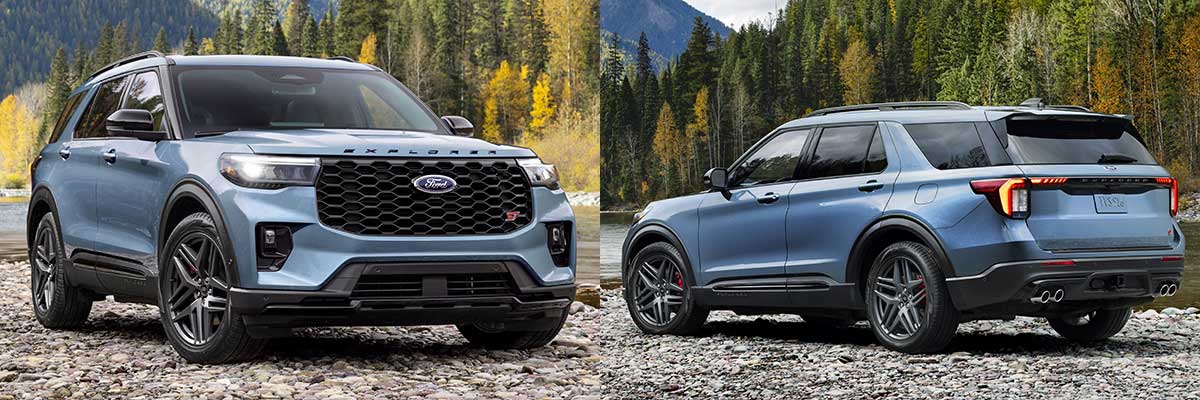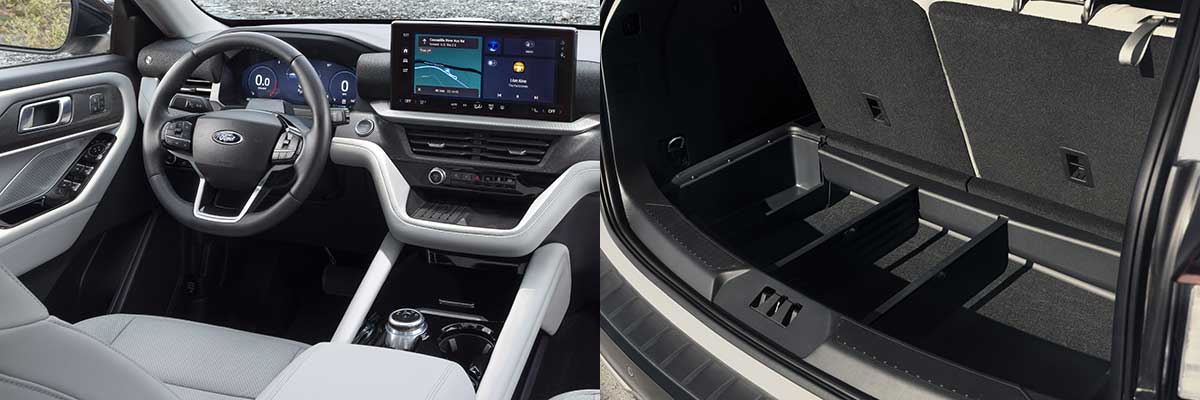2025 Ford Explorer
Explorer gets a significant makeover for the 2025 model year, adding features, refinement, technology and a bit of class.
The Ford Explorer has been a staple in the midsize crossover market since its introduction in 1991, helping to popularize the segment with its blend of capability and family-friendly design. Over the years, it has evolved through multiple generations, with the latest refresh arriving for the 2025 model year. This update includes revised lighting, a redesigned front fascia, and a more modernized interior. The Explorer continues to offer seating for up to seven passengers and is available exclusively as a 4-door wagon. It competes with other three-row SUVs such as the Chevrolet Traverse, Honda Pilot, Hyundai Palisade, Kia Telluride, Mazda CX-90, Nissan Pathfinder, Toyota Highlander, and Volkswagen Atlas.
For 2025, the Explorer is available in four trims: Active, ST-Line, Platinum, and ST. Active and ST-Line come with a turbocharged 2.3-liter EcoBoost inline-four, producing 300 horsepower and 310 lb-ft of torque. Optional on the Platinum and standard on the the high-performance ST trim is a twin-turbocharged 3.0-liter EcoBoost V6, generating 400 horsepower and 415 lb-ft of torque. Both engines pair with a conventional 10-speed automatic transmission, but the 3.0-lliter gets SelectShift capability and paddle shifters. Rear-wheel drive is standard, with all-wheel drive available as an option. Regardless of trim or drivetrain, the Explorer maintains a towing capacity of up to 5,000 pounds when properly equipped.
Pricing for the 2025 Ford Explorer starts at approximately $39,755 for the base Active trim, while the ST-Line comes in at $44,515. The Platinum trim is priced at $51,655, and the high-performance ST model starts at $55,505. Standard safety features include adaptive cruise control, lane-keeping assist, blind-spot monitoring, and forward collision warning with automatic emergency braking. Available options include Ford's BlueCruise hands-free highway driving system, a panoramic sunroof, premium leather seating, and a high-end Bang & Olufsen audio system, allowing buyers to tailor their Explorer to their needs.

The 2025 Ford Explorer offers two powerful engine options. The turbocharged 2.3-liter EcoBoost provides a responsive and efficient driving experience. This engine is well-suited for daily commuting and highway cruising, offering smooth acceleration and respectable fuel economy. While it may not be the most aggressive option, it provides ample power for most driving scenarios and is more powerful than many standard V6 engines in the class.
For those seeking a more exhilarating ride, the twin-turbocharged 3.0-liter EcoBoost V6 steps up with 400 horsepower and 415 lb-ft of torque. This engine, optional in the Platimum and standard in the ST, enhances the Explorer's performance with stronger acceleration and a sportier feel. It provides a noticeable boost in power, making highway passing effortless and delivering a more engaging driving experience. Additionally, both engines are paired with a smooth shifting 10-speed automatic transmission.
Maximum towing capacity of 5,000 pounds across all trims when properly equipped is quite good for the class. Combined with the rear-drive bias, this makes Explorer a solid choice for hauling boats, trailers, or other recreational gear.
The Explorer's all-wheel drive (AWD) does not have a low range and is not intended for extreme off-road use. However, the AWD system continuously monitors road surfaces and adjusts power distribution between the front and rear wheels to optimize grip featuring multiple drive modes, allowing drivers to tailor performance to different environments, ensuring
The 2025 Ford Explorer offers competitive fuel economy figures across its two engine options. The turbocharged 2.3-liter EcoBoost inline-four achieves an EPA-estimated 24 MPG combined (20 city / 29 highway) with rear-wheel drive, while the all-wheel-drive version slightly lowers efficiency to 23 MPG combined (20 city / 27 highway). The twin-turbocharged 3.0-liter EcoBoost V6 delivers 21 MPG combined (18 city / 25 highway) with rear-wheel drive, and 20 MPG combined (18 city / 25 highway) with all-wheel drive. Both engines run on regular gasoline.
In real-world driving conditions, fuel economy can vary based on driving style, terrain, and load. Expect the 2.3-liter engine performs close to its EPA estimates, especially on highway trips, while city driving may see slightly lower numbers. The 3.0-liter V6, being more performance-oriented, tends to return slightly lower real-world mileage, particularly in stop-and-go traffic. The fuel tank capacity for the Explorer is 17.9 gallons, providing a total driving range of approximately 430 miles for the 2.3-liter engine and around 400 miles for the 3.0-liter engine.
The 2025 Ford Explorer delivers a balanced driving experience, combining confident handling with a comfortable ride. Thanks to its rear-wheel-drive platform, the Explorer feels more composed and agile compared to front-wheel-drive competitors. Steering is precise, with a somewhat heavy feel. The available all-wheel-drive system enhances grip on slippery surfaces, making it a solid choice for those in regions with harsh weather. While not a dedicated off-roader, the Explorer's suspension and drivetrain allow it to handle light trails and uneven terrain with ease.
Ride quality in the 2025 Explorer is smooth and refined, with a suspension tuned to absorb road imperfections effectively. Whether cruising on the highway or navigating urban streets, the Explorer maintains a composed demeanor, minimizing harsh impacts from potholes or rough pavement. Ride quality on the ST suffers somewhat thanks to its more aggressive suspension settings and larger wheels and tires.
Interior noise levels are impressively low, thanks to enhanced sound insulation and acoustic glass. Wind and road noise are kept to a minimum, creating a serene cabin environment.

The 2025 Ford Explorer receives a significant interior upgrade, focusing on improved materials and a more refined design. Ford has enhanced the cabin with soft-touch surfaces, premium upholstery, and a redesigned dashboard, creating a more upscale feel. The center console and door panels now feature higher-quality materials, addressing previous concerns about interior durability and aesthetics.
Technology plays a central role in the 2025 Explorer's cabin, with a 13.2-inch center touchscreen running Ford's latest SYNC system, offering wireless Apple CarPlay and Android Auto compatibility. A 12.3-inch digital instrument cluster display provides real-time vehicle data, while an available Head-Up Display projects key driving information onto the windshield.
For 2025 Ford also added BlueCruise, Ford's advanced hands-free highway driving system, on select trims. This technology allows drivers to operate the vehicle without manually steering or accelerating on pre-mapped highways, known as Blue Zones. Using a combination of cameras, radar, and GPS, BlueCruise ensures safe and adaptive driving by maintaining lane position, adjusting speed, and monitoring surrounding traffic. The system also includes driver-facing cameras to ensure the driver remains attentive, adding an extra layer of safety. BlueCruise is available on ST-Line, ST, and Platinum trims, with a one-year subscription included on certain models. After the trial period, owners can opt for monthly or annual plans to continue using the service.
The 2025 Ford Explorer offers a spacious and versatile three-row seating configuration, accommodating six or seven passengers depending on the chosen setup. The first-row seats provide ample comfort, with available heated and ventilated options for both the driver and front passenger. The second row can be configured with either a bench seat or captain's chairs, allowing for easier access to the third row. The third-row seats, while slightly more compact, still offer 32.2 inches of legroom, making them suitable for children or shorter adults. Both the second and third rows feature fold-flat functionality, enabling quick and effortless expansion of cargo space when needed.
Cargo capacity in the 2025 Explorer is generous, with 16.3 cubic feet of storage behind the third row, expanding to 46 cubic feet when the third row is folded. For maximum cargo-hauling capability, folding both the second and third rows provides 85.8 cubic feet of total cargo space. Interior storage solutions include deep door pockets, a large center console, and under-floor compartments, ensuring ample space for smaller items. The power liftgate, available on higher trims, makes loading and unloading more convenient, further enhancing the Explorer's practicality.
Bottom Line -- Without a doubt, Ford has upped the ante in the midsize crossover segment. With improvements in features, comfort, refinement, materials and technology, Explorer brings plenty to the table. By utilizing a rear-drive platform, Ford is the better choice for heavy hauling and towing, and in ST trim, handling prowess. Others in the class might offer more interior room, or a lower price, but Explorer tries, and mostly succeeds, in offering a complete package to a wide range of buyers.
